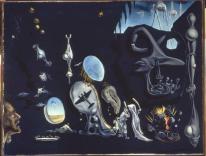Filmmakers often must leave much good material on the cutting-room floor as they edit. Morgan Atkinson, who produced the documentary Soul Searching: The Journey of Thomas Merton, solves that problem by compiling into a book excerpts from the many interviews he conducted while making the film. Atkinson also writes about his own spiritual journey, which was influenced by Merton, and his visit to Gethsemani, Merton’s monastery in Kentucky.
Atkinson restricts his attention to Merton’s life in the United States, arranging quotations from interviews and a few well-chosen photographs to convey the sights and sounds of New York City, Kentucky, a few of the sites where Merton dreamed of having a new hermitage, and the California coast Merton visited before his fateful journey to Asia, where he died in 1968. These locations are also explored in the film, which includes scenes of New York City, especially the area around Columbia University. The documentary also includes many views of the Gethsemani monastery, including pictures of Merton at work and prayer there, and images of the drawings and calligraphy Merton produced. The book and the DVD of the film are available separately, but this special edition that includes both is the one to purchase and savor.
In his book, Atkinson wonders whether another book about Merton, whom many consider the greatest English-language spiritual writer of the twentieth century, is necessary. For that matter, he wonders whether his film is necessary, considering the fine documentary made by Paul Wilkes in 1985 (Merton). Nevertheless, Atkinson goes off to interview the people whom he calls “the Merton choir”: scholars and friends and colleagues of Merton’s, some of whom were members of the Trappist order at Gethsemani during Merton’s years there.
Many members of the choir will be familiar to those who are interested in Merton, but I found the interviews with the Trappist monks to be the most revealing and interesting. Atkinson should be thanked for providing extensive transcripts of his interviews with people like Dom John Eudes Bamberger, James Conner, Paul Quenon, and Maurice Flood, which allow us to know more about the life of the monastery, the mind of the monk, and the character of the man they all knew as Fr. Louis, or Louie.
Bamberger explains the process of formation that a Trappist undergoes and the true meaning of the monastic vows. “Being formed as a monk is being trained to live at deeper levels of your personality and to enter the deeper center of your heart,” he writes. Bamberger also describes how the American man who identifies himself as an independent person is tested by monastic asceticism and obedience. “The monk seeks to bear witness to a truth that transcends him, transcends the world, and he seeks to become a servant of that truth.”
The Trappists talk about Merton’s faithfulness to Gethsemani, his personal humility, and his excellence as a teacher when he was made director of novices. Having been taught by Merton, Bamberger and the other Trappists can testify to his conviction that he had something to say to the world, not just to the monks. Some of the choir members help us understand Merton’s personal transformation within the monastery, which led him to declare that the man who wrote The Seven Storey Mountain was dead. The new Merton became a speaker on the social ills of the day and a correspondent to both the powerful and the lowly. The book also details Merton’s partial withdrawal from the life of the monastery in pursuit of solitude. At first, the abbot gave him permission to spend part of every day in a tiny tool shed in the woods. It was called St. Ann’s. Eventually, Merton went to live in the hermitage to look deeper into his own union with God.
From his early days, Merton was a writer, and being forced by the abbot to write his autobiography, The Seven Storey Mountain, less than ten years after his entrance into the monastery in 1941 allowed him to respond to his hidden vocation. One bonus of the film is the selection of the advertisements and reviews (not included in the book) that heralded the success of Merton’s best-selling autobiography. Excerpts from reviews in the New York Times, the Chicago Tribune, and Newsweek illustrate how the book was received when it was published. In an advertisement, the publisher exclaims, “This book has more meaning than ever before”—probably an allusion to the heightened interest in introspection and spiritual seeking following World War II. Those who pursued the spiritual life filled monasteries like Gethsemani: when Merton entered the abbey in 1941, there were 80 monks. By the early 1950s, thanks in part to The Seven Storey Mountain, the abbey was filled with 240 monks. In fact, this growth led Gethsemani to found daughter monasteries.
As pastor of Corpus Christi Church in New York City, where Merton was baptized a Roman Catholic in 1938, I can testify that Atkinson has done us all a great favor in preserving the text of his many interviews about Merton, as well as offering insight into his own spiritual life. Forty years after his death, Merton’s influence is strong, and countless people, following his example, come to Corpus Christi out of a desire to reach deeper into their own religious and spiritual life. Merton speaks to each generation about prayer, social concern, interreligious dialogue, and the search for the true self. Soul Searching helps us meditate on this legacy, and may send many more people back to the books that Merton himself wrote.
Related: Merton’s Enlightenment, by Paul Wilkes
Bernard G. Prusak reviews two collections of Merton’s letters and journals
Merton: Persona Non Grata? by the Editors

